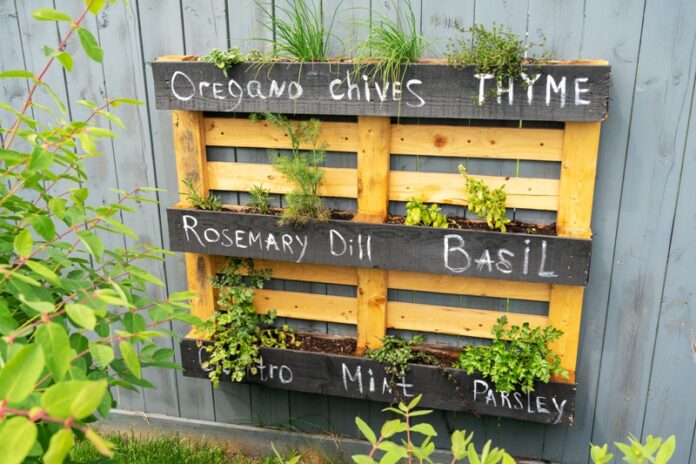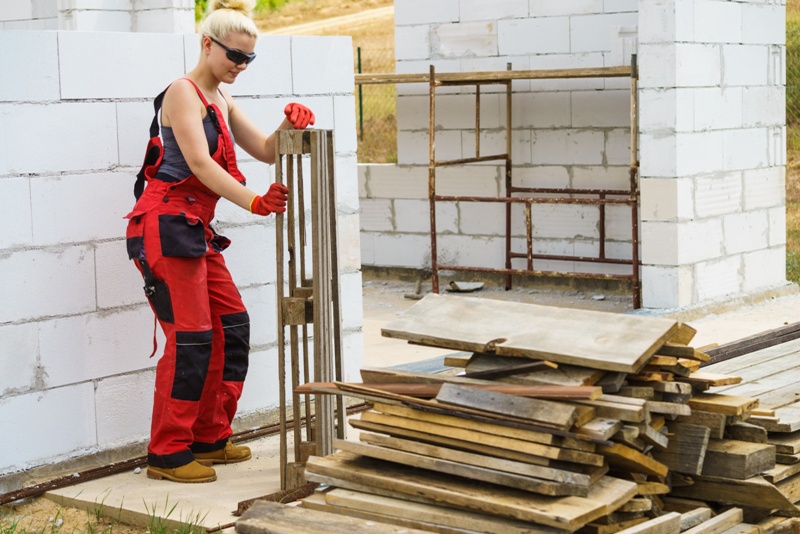Pallets are great for projects that call for reusing old materials. You can make all sorts of beautiful things from wood pallets. They’re made from solid wood, they’re sturdy, and are usually termite-proof. Plus, you know—recycling is always a good idea. You wouldn’t be adding to the global waste problem.
This is one of the reasons why wood pallets are famous among DIYers. Pallets are also extremely versatile—you can transform them from being an industrial staple to gorgeously crafted pieces that can both be useful and decorative. But you can’t just pick up any old wooden pallets that are lying around and use them for your project. Not all pallets are meant for this transformative process. But how would you choose the right pallets for your projects?
Choosing The Right Pallets
The main reason why you can’t just use any old pallets is that used wood pallets are sometimes contaminated with toxic and harmful chemicals, not to mention bacteria and other gross stuff that you wouldn’t want to be anywhere near your home. Find out first where the pallets came from, what’s been on them, and what projects you’re going to use them for.
However, just because you’re using pallets for your project doesn’t mean you have to use old ones. You can also use new, unused ones straight from the manufacturers. There are repaired pallets, remanufactured pallets, and others that are perfectly safe to use. You can try cleaning old, grotty-looking pallets, but it really isn’t advisable. Wood is porous and is very absorbent, so washing it with soap and water wouldn’t work. Bacteria in wood are embedded in the wood fibers.
If you can’t find clean, suitable wooden pallets for your project, your best bet would be new ones; you can contact manufacturers like Challengerpallet.com and consult with them about your project. Chances are, they have just the wooden pallets that would suit your needs.
But if you want to mix up your project with some vintage, old-wood look, make sure they’re non-toxic and safe to use. Also, you wouldn’t want overused pallets. They’d be dry, brittle, and are likely prone to splitting. Look for pallets that you can actually work with.
Sometimes, you’ll find pallets that have markings on them. Typically, pallets marked DB, KD, HT, or EPAL mean they haven’t been subjected to chemical treatment. DB means the pallets did not undergo any treatment. HT, EPAL, and KD signify that the pallets have either been heat-treated or kiln-dried. These pallets are safe to reuse.
Pallets To Avoid
In general, avoid pallets that are cracked or broken, or old and weathered. Besides the obvious signs, here are also other things to watch out for when using pallets:
- Pallets used for carrying food: Avoid pallets that have been used to carry food. Usually, pallets that have been used to carry food have a wheat stalk icon. Pallets like these are likely to be carrying E. coli and Listeria, so avoid using them unless you’re building a compost bin.
- Pallets treated with chemicals: Pallets with ‘MB’ markings mean they have been treated with the chemical methyl bromide, which is a neurotoxin. It unsafe for you to use a pallet marked with these letters.
- Pallets with petroleum stains: Stains like these are impossible to remove. Painting over the stains wouldn’t work either. You shouldn’t risk working with stained pallets. They may have serious side effects, especially if you’re sanding them down for your project.
Keep in mind that if you can’t find clean and safe wooden pallets, you can contact pallet manufacturers and tell them what you need. They sometimes have used wooden pallets that are safe for repurposing.
Pallet Projects
Now that you know what pallets to use and what to avoid, here are some ideas for your DIY pallet project for your home and garden:
1. Wood pallet garden
Repurposing an old wooden pallet as a pallet garden is almost poetic—wood is reunited with the earth from which it came. Moreover, a wood pallet garden is practical and easy to create. A wood pallet garden could make your crop easy to organize. Place your pallet garden in a spot in your garden where dirt is fertile.
2. Raised Garden Bed
The raised garden bed is still one of the top choices for vegetable or flower gardening in a limited space. The dirt warms up quickly in raised beds, and plants on the ground won’t compete with the vulnerable plants because they’ll be elevated. The loose, crumbly dirt on the raised garden encourages the healthy development of root systems on various ornamentals and edibles.
Also, to stop the soil from ‘leaking’ out whenever you water your plants, you could line the raised garden bed with a piece of landscape fabric. Ideally, a raised garden bed’s height is 6 to 12 inches. If you want them higher, be sure to use ‘staking’ to reinforce the walls. This will stop the raised garden from bowing outward.
3. Bedframe
One of those projects that you’d really appreciate because you get to lie on it at the end of the day. This would take more than a few pallets though, and more tools than just nails and a hammer. You’d need about four pallets, or maybe more if you want a more expansive bed size. And while its legs are usually woodblocks, you can put in wheels instead. Moving the bed around would then be easier.
4. Wall Planter
If you’re a homeowner who would like to have an herb or flower garden but lacks the space, a vertical garden just might be for you. A wall planter could be made up of pallets filled with soil and plants, or you could use the pallet as an anchor where you can attach clips to hold a few pots. It’s important to mount them securely. You can use wood screws, metal brackets, or cleats. For added stability, make sure the bottom of your wall planter reaches the ground.
5. Pallet Couch
If you’ve tried the bedframe, then a couch would be easier for you. A pallet couch in your patio or living room would add a nice touch. You might have to do a little sawing for the armrests, though, if you’re adding this feature. But the other parts can fall neatly into place with a little planning and some nifty arrangements.
6. Pallet Garden Bench
A garden bench made from a repurposed pallet is a welcome sight for a tired gardener. Although a wood pallet doesn’t look like you could transform it into something inviting, a judicious application of paint and a little creativity will do wonders. Add some pretty little throw pillows in there, and the transformation could surprise you. And don’t forget the most important ingredient: a lot of elbow grease.
7. Pallet Coffee Table
You can put this coffee table on the patio or in your living room. It’s relatively easy to make. You can also add in some features like extra storage beneath the table. Ensure your measurements are on point so that there won’t be any space between the slats.
8. Compost Bin
A dedicated gardener requires a compost bin in the garden for humus production. There are few things more valuable to a gardener than humus—a dark, nutrient-rich soil that’s extremely helpful for a plant’s growth. When making a compost bin from pallets, it’s best to use heavy-duty pallets. You can use these as the bin’s sidewalls, fastened with brackets, or you can simply wire them together. Just make sure they won’t come undone.
If you have a small garden plot, a single bin might be enough. But for those with larger garden spaces, a three-bin, open-sided system would be very beneficial. One bin can be used for holding kitchen scraps and fresh garden rubbish, another bin for turning and moving the decomposing materials, and another bin for the ready-to-use, finished compost. They may not be pretty to look at, but you can always add flowering vines around the bin.
9. Garden Walkway
If you still have a few pieces of wooden pallets laying around, and you’re not keen on doing any more carpentry, turning those pallets into a walkway is perfect. You could turn them into a design element in your garden. Put the walkway in your garden’s low-traffic area, though—don’t let carts or wheelbarrow tread on them.
Weathered wooden pallets would be ideal as a walkway. To get more out of them, don’t let the pallets lay directly on the dirt. Dig a few inches underneath the path, and fill with gravel. This simple solution would drain the water away from the garden path and prevent, or at least delay, rot on the wooden pallets.
10. Garden Swing
Sure, a garden swing is common, but a garden swing bed isn’t. A pre-made garden swing bed can cost you a pretty penny, which could make you more anxious instead of relaxed. That would defeat the purpose of the garden swing bed. Use a 2 x 4 lumber to shore up two wooden pallets and put a covered mattress on top. The type of cover mattress is up to you.
Perhaps you could have someone who knows their way around a sewing machine to make a cushion with fabric suited for outdoor patios. You’d also need ropes with a good load limit, and of course, a sturdy branch from which to hang the garden swing.
Conclusion
There are many ways you can repurpose wooden pallets. Pallets, in fact, are popular among DIYers. Be careful, though, as not all pallets are safe to reuse. Use the tips in this article to find wooden pallets that are safe. If you aren’t sure of the pallets’ provenance, manufacturers can provide pallets that are perfect for your needs.



















